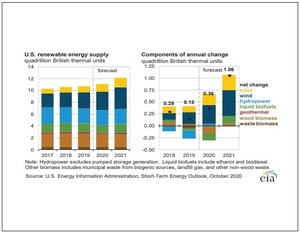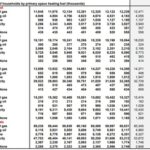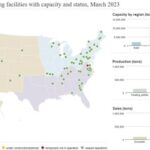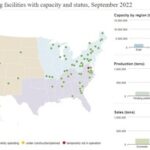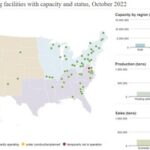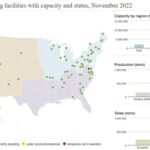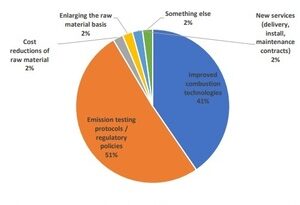EIA: 1.8 million households to use wood as a primary heating fuel
Energy Disrupter
- <img src="http://biomassmagazine.com/uploads/posts/web/2020/10/resize/EIASTEOOCt20202_16020222507432-300×300-noup.jpg" title="SOURCE: U.S. Energy Information Administration
</small>”> - <img src="http://biomassmagazine.com/uploads/posts/web/2020/10/resize/EIASTEOOct20201_16020222517697-300×300-noup.jpg" title="SOURCE: U.S. Energy Information Administration
</small>”>
ADVERTISEMENT
The U.S. Energy Information Administration released its Winter Fuels Outlook and an updated Short-Term Energy Outlook on Oct. 6, reporting that approximately 1.8 million households will use cord wood or wood pellets as their primarily residential spacing heating fuel this winter.
The Winter Fuels Outlook explains that the COVID-19 pandemic has significantly affected energy price and consumption patterns this year. The average U.S. consumer has increased residential energy uses but has decreased the use of transportation-related sources of energy. That trend is expected to continue into the winter of 2020-’21. EIA forecasts that U.S. residential energy consumption will be higher than last winter. More people working and attending school from home is expected to increase demand for space heating at any given temperature relative to past winters. In addition, forecasts from the National Oceanic and Atmospheric Administration indicate much of the U.S. will experience a colder winter when compared to last year.
The EIA estimates approximately 1.4 percent of U.S. households will use corn wood or wood pellets as their primary residential space heating fuel during the 2020-’21 winter. That percentage equates to nearly 1.8 million households nationwide, a 10.1 percent drop when compared to last winter. Another 8 percent of households are expected to use wood as a secondary source of heat.
According to the EIA, about one-fourth of rural households used wood for primary or secondary space heating in 2015, as opposed to 6 percent of urban households. Wood use was most common in New England, where 21 percent of households used wood.
Regionally, 218,000 households in the Northeast are expected to use wood as a primary space heating fuel this winter, down 37.9 percent, along with 429,000 households in the Midwest, down 9.7 percent; 451,000 households in the South, down 3.2 percent; and 667,000 households in the West, down 0.6 percent.
The EIA’s October STEO predicts electricity generation from renewable sources will increase from 17 percent in 2019 to 20 percent in 2020 and 22 percent in 2021.
In the electric power sector, biomass expected to be used to generate 27.9 billion kilowatt hours (kWh) of electricity this year, including 15.6 billion kWh from waste biomass and 12.3 billion kWh from wood biomass. Generation from biomass reached 28.8 billion kWh in 2019, including 15.7 billion kWh from waste biomass and 13 billion kWh from wood biomass. In 2021, generation from biomass is expected to increase to 31.2 billion kWh, including 16.4 kWh from waste biomass and 14.9 billion kWh from wood biomass.
Across other sectors, power generation from biomass was at 29.7 billion kWh in 2019, including 2.8 billion kWh from waste biomass and 26.8 billion kWh from wood biomass. Generation in 2020 is expected to fall to 29.1 billion kWh, including 2.8 billion kWh from waste biomass and 26.3 billion kWh from wood biomass. 2020 generation levels are expected to be maintained through next year.
The electric power sector is expected to consume 0.233 quadrillion Btu (quad) of waste biomass this year, down from 0.236 quad in 2019, but increasing to 0.244 quad in 2021. The sector consumed 0.211 quad of wood biomass in 2019, with consumption expected to fall to 0.2 quad in 2020, and increase to 0.241 quad in 2021.
The industrial sector consumed 0.16 quad of waste biomass last year. Consumption is expected to increase to 0.163 quad this year before falling to 0.162 quad in 2021. The sector is expected to consume 1.355 quad of wood biomass in both 2020 and 2021, down from 1.473 quad in 2019.
The commercial sector is expected to consume 0.035 quad if waste biomass in 2020 and 2021, down from 0.036 quad in 2019. The sector also consumed 0.84 quad of wood biomass in 2019. That level of consumption is expected to remain flat through 2020 and 2021.
The residential sector is expected to consume 0.514 quad of wood biomass in 2020 and 2021, down form 0.529 quad in 2019.
Across all sectors, waste biomass consumption is expected to be at 0.432 quad this year, increasing to 0.441 quad in 2021. Consumption of wood biomass was at 0.433 quad in 2019. Wood biomass consumption was at 2.297 quad in 2019, and is expected to fall to 2.152 quad in 2020, but rebound partially to 2.194 quad in 2021.
In the electric power sector, biomass generating capacity was at 6,672 megawatts (MW) in 2019, including 3,945 MW of waste biomass capacity and 2,727 MW of wood biomass capacity. Capacity by the end of 2020 is expected to fall to 6,628 MW, including 3,902 MW of waste biomass capacity and 2,727 MW of wood biomass capacity. Biomass capacity is expected to reach 6,638 MW by the end of 2021, including 3,912 MW of waste biomass capacity and 2,727 MW of wood biomass capacity.
Across other sectors, biomass capacity was at 6,424 MW at the end of last year, including 786 MW of waste biomass capacity and 5,637 MW of wood biomass capacity. Capacity is expected to increase slightly by the end of 2020 to 6,428 MW, including 802 MW of waste biomass capacity and 5,626 MW of wood biomass capacity. Biomass capacity is expected to hold steady through 2021.

